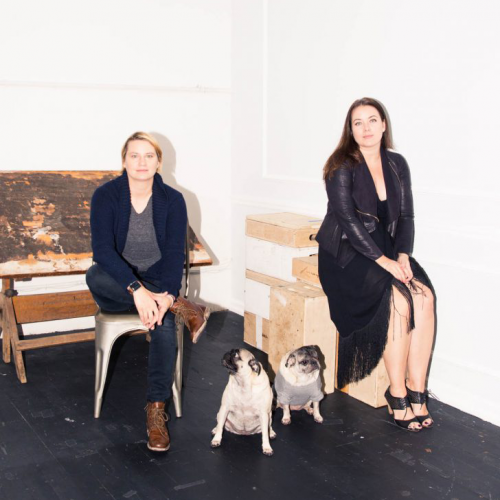In honor of our 5 Year Anniversary at Visual Country, we sat down with CEO Amber Lee and Creative Director Meagan Cignoli to reflect on our company roots and learn how the start-up became so successful.

In early 2013, Meagan Cignoli, was a successful fashion photographer living in Brooklyn. Amber Lee and Meagan had known each other for many years, and worked closely on a number of campaigns in the past for brands like Google and Kraft. Lee was working at eBay at the time, helping to launch its same-day delivery service, eBay Now, on the east coast.
Then Twitter launched Vine, and their lives quickly changed.
Amber: “I had spoken with Meagan many times about her career and life… her travels around the world, studying fashion at FIT, Spanish and photography in Cuba, and all the ways she has applied her creative talents. As an artist and freelance photographer, Meagan was making a nice living, but was actively searching for a way to put those disparate creative talents together toward a singular purpose. In Vine, she found exactly what she was looking for.”
Native video was new to social. Instagram video wasn’t out, you couldn’t post a video to Twitter, and people were sharing YouTube videos on Facebook. Given that environment, Meagan, what did you see in Vine that made it so compelling and how did you leverage that?
Meagan: “In those very early days, everyone was still figuring out what to do with social video and how to use Vine to create something fresh and different. I quickly realized that by focusing on Vine, I was beginning to carve out my own creative niche and develop a new style. Vine was a video platform, but I approached it from the perspective of a fashion photographer, which ended up giving me an advantage.”
“Focus on a clearly defined niche with an obvious need. Don’t try to be everything to everyone.”
Amber: “Meagan began experimenting with Vine soon after its launch and it quickly became her sole focus. She was working tirelessly on Vine at that time, to the point where I began to worry about her photography career and prompted her to get back to it. Luckily, she didn’t listen to me. I think the lesson here is to focus on a clearly defined niche with an obvious need. Don’t try to be everything to everyone.”
Meagan: “Agreed. Focus on one thing and try to do it better than anyone else. Find a gap, and fill it. Otherwise you risk spreading yourself too thin.”
How did you begin working with brands?
Amber: “Meagan was one of the earliest producers of stop-motion animation on the platform. She brought a unique visual aesthetic and direction that attracted fans at an incredible rate and became one of the most recognizable styles of short-form video. Once the fans came, the brands quickly followed. Without Meagan’s vision and singular focus, the opportunity would have passed by very quickly.”
“Find a great partner whose skill set complements your own so that you can accomplish a lot by yourselves prior to making big hires.”
How did Visual Country operate in the beginning and what made you two such a great team?
Meagan: “I think the key to our initial and continued success is our ability to work well together while focusing on different aspects of the business. Amber had a lot of prior experience managing and working in startups and tech, and I had a lot of experience on the creative side in various capacities. This enabled us to get a lot done without spending tons of money. I would recommend this approach to any entrepreneur. Find a great partner whose skill set complements your own so that you can accomplish a lot by yourselves prior to making big hires.”
Amber: “When we started the company, Meagan and I were working out of an apartment in Brooklyn. We turned the living room and second bedroom into a studio and office and covered the entire place in lights and crafting materials. We had two part-time employees and together we did everything from directing the videos, to contracts and accounting, to sales, marketing, and cleaning the office—no job was too big or too small. By keeping costs low at the beginning and hiring a flexible workforce, we were able to move the business to a large studio Manhattan pretty quickly and begin growing the team.”
“Have an immediate revenue plan. Then test and tweak it early with laser focus on winning your first ten customers.”
In the early stages of a company, there are so many things to focus on. What were the priorities for Visual Country and what should other startups be focusing on?
Amber: “I think that our first focus was to find our niche and the need we could fulfill, along with how we were going to make money consistently. A lot of startups focus on building a product that will scale, before they even have demand that needs scale. Don’t worry about scaling the business, worry about having a business to begin with — be able to show investors and customers that people want and need your service or product. Once brands started contacting us, we knew we had found our niche and revenue source. Even so, we still had to continue testing things such as our pricing and marketing. So my advice to any startup would be to have an immediate revenue plan. Then test and tweak it early with laser focus on winning your first ten customers. It’s important to test the market before spending your money on tech or trying to build the perfect product. Groupon was started with a PDF coupon for pizza. Just worry about getting those first ten customers.”
Meagan: “Testing your product or service quickly, even though it will be a little rougher than you envision, and getting feedback are key to growing. The early stages are filled with excitement and big ideas, but it’s important to be cautiously optimistic. There is no harm in taking some time to test the waters and get the business started. So keep your day job! Allow that money to keep your bills your rent paid on time so you can relieve the stress of bootstrapping with no income. Build your business using nights and weekends, even though it will mean giving up some of your social life. Spend as much of your time as you can while still making sure to get in some R&R. Prove that your business can make you money, build it up, scale it up until your nights and weekends are not enough, and you have enough cash flow to pay those bills.”


